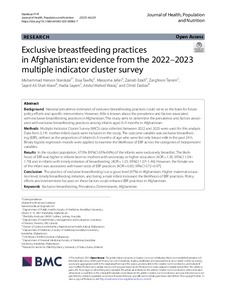Exclusive breastfeeding practices in Afghanistan: evidence from the 2022–2023 multiple indicator cluster survey
Stanikzai, Muhammad Haroon; Tawfiq, Essa; Jafari, Massoma; Ezadi, Zainab; Tareen, Zarghoon; Alawi; Sayed; Ali Shah; Sayam, Hadia; Wasiq, Abdul Wahed; Dadras, Omid
https://urn.fi/URN:NBN:fi-fe2025082786120
Tiivistelmä
Background
National prevalence estimates of exclusive breastfeeding practices could serve as the basis for future policy efforts and specific interventions. However, little is known about the prevalence and factors associated with exclusive breastfeeding practices in Afghanistan. This study aims to determine the prevalence and factors associated with exclusive breastfeeding practices among infants aged 0–5 months in Afghanistan.
Methods
Multiple Indicator Cluster Survey (MICS) data collected between 2022 and 2023 were used for this analysis. Data from 3,141 mother-infant dyads were included in the study. The outcome variable was exclusive breastfeeding (EBF), defined as the proportion of infants 0–5 months of age who were fed only breast milk in the past 24 h. Binary logistic regression models were applied to examine the likelihood of EBF across the categories of independent variables.
Results
In the studied population, 67.0% (95%CI 65%-69%) of the infants were exclusively breastfed. The likelihood of EBF was higher in infants born to mothers with secondary or higher education [AOR = 1.35, 95%CI 1.04–1.76] and in infants with timely initiation of breastfeeding [AOR = 1.25, 95%CI 1.07–1.46]. However, the female sex of the infant was associated with lower odds of EBF practices [AOR = 0.83, 95%CI 0.72–0.97].
Conclusion
The practice of exclusive breastfeeding is at a good level (67%) in Afghanistan. Higher maternal education level, timely breastfeeding initiation, and being a male infant increased the likelihood of EBF practices. Policy efforts and interventions focused on these factors could enhance EBF practices in Afghanistan.
Kokoelmat
- Rinnakkaistallenteet [27094]
